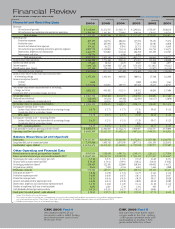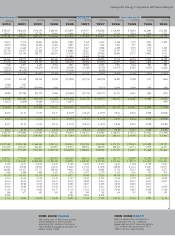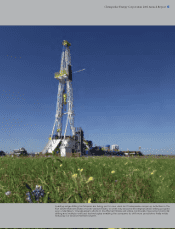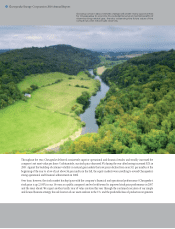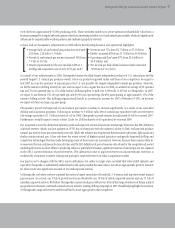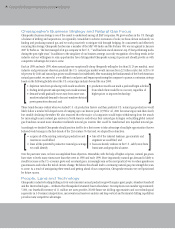Chesapeake Energy 2006 Annual Report Download - page 14
Download and view the complete annual report
Please find page 14 of the 2006 Chesapeake Energy annual report below. You can navigate through the pages in the report by either clicking on the pages listed below, or by using the keyword search tool below to find specific information within the annual report.
12
Chesapeake Energy Corporation 2006 Annual Report
Technology
In another example of early recognition of evolving industry trends, Chesapeake’s management team in the late 1990s correctly
anticipated that better technologies applied to unconventional reservoirs in a time of structurally higher natural gas prices would
result in the discovery and development of many tcf of new natural gas reserves.
As I think back on Chesapeake’s founding in 1989, this is exactly what we started our company to accomplish – utilize the new
technology of drilling horizontal wells in unconventional reservoirs to avoid the risk of drilling a dry hole. We began by developing
southern Oklahoma fractured carbonate rocks such as the Sycamore, Woodford, Hunton and Viola formations, and later expanded
into various Austin Chalk plays of south-central and southeastern Texas. We did not know enough at the time to brand these
fractured carbonates as “unconventional,” but they certainly were. For a long time our company’s reputation paid a price for
focusing on these fractured carbonates, reservoirs that for decades the industry knew contained oil and natural gas, but were not
economical to develop. Ironically, what was contrarian and controversial 18 years ago has today become a widely followed strategy
in our industry.
While we were very successful in cracking the code to these unconventional reservoirs in Oklahoma and Texas
in the late 1980s and early 1990s, we were less successful in the mid-1990s extending our early success in the
Austin Chalk to Louisiana. That painful failure in Louisiana and the collapse of oil and natural gas prices in
1998-99 led to Chesapeake’s retreat, for a time, from unconventional plays. However, when it became clear
after 2000 that unconventional formations might yield vast reserves of previously uneconomical natural gas
to horizontally drilled wells with fracture stimulations isolated in discrete intervals (a technology not previously
perfected), Chesapeake returned to its roots and began to aggressively pursue new unconventional gas resource
plays with substantial upside.
The most notable of these unconventional plays is the Fort Worth Barnett Shale. Centered around Fort Worth,
Texas, the Fort Worth Barnett Shale has emerged as one of America’s largest natural gas fields and is the best
example of what can happen at today’s three-way intersection of improved horizontal drilling and completion
technology, a better scientific understanding of how shales work and structurally higher natural gas prices.
This play is currently responsible for approximately 4% of U.S. natural gas production and almost 10% of the
nation’s drilling activity. Its importance to the U.S. will greatly increase in the years ahead as Chesapeake and others drill thousands
of wells to develop this exceptionally large natural gas resource base estimated to contain at least 25 tcfe.
Chesapeake entered the Fort Worth Barnett Shale in 2002 through an acquisition that included 4,000 net acres in the play (for
which, at the time of the acquisition, we gave no value). Since that time, we have assembled almost 200,000 net acres of leasehold
in what is referred to as the Tier 1 area of the play, principally in Johnson, Tarrant and western Dallas counties. In the Tier 1 area,
Chesapeake now owns the industry’s largest leasehold position and has drilled or acquired nearly 400 wells that are today producing
about 285 million cubic feet of natural gas equivalent (mmcfe) (190 mmcfe net to Chesapeake). We are currently the fourth-
largest producer of natural gas in the Barnett play, but with our current drilling activity of 25 rigs moving to a projected industry-
leading 35 rigs by midyear 2007, we anticipate becoming the second-largest producer of natural gas from the Fort Worth Barnett
Shale by year-end 2007.
This year Chesapeake expects to invest approximately $1 billion in the Fort Worth Barnett Shale to drill nearly 400 gross wells.
While this represents just 25% of our drilling capital expenditures for the year, we anticipate this drilling program will be prolific
enough to replace nearly all of Chesapeake’s production during 2007, allowing our remaining capital expenditures to generate
significant overall growth. Furthermore, this play will remain the foundation of our growth for years to come as we currently have
enough leasehold to drill 2,300 additional net wells, representing almost 4 tcfe of future reserves. In recognition of the play’s
attractiveness, we continue to acquire more leasehold in the play, especially in and around metropolitan Fort Worth, where we
believe the most favorable geology exists and where the best wells will likely be drilled.
0605040302
3-D Seismic Data
Acres in millions
20
16
12
8
4
0


